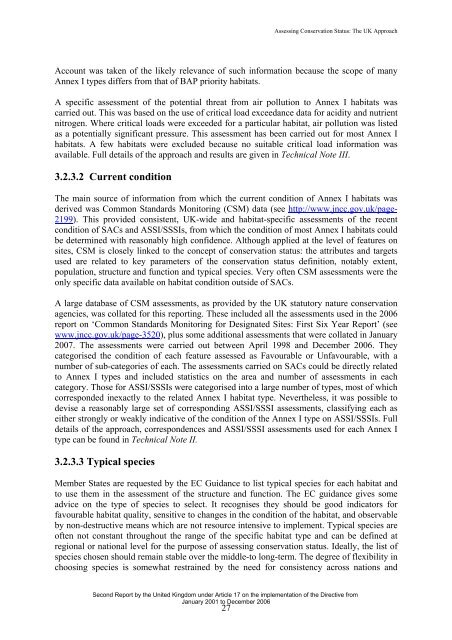Assessing Conservation Status: The UK Approach - JNCC
Assessing Conservation Status: The UK Approach - JNCC
Assessing Conservation Status: The UK Approach - JNCC
Create successful ePaper yourself
Turn your PDF publications into a flip-book with our unique Google optimized e-Paper software.
<strong>Assessing</strong> <strong>Conservation</strong> <strong>Status</strong>: <strong>The</strong> <strong>UK</strong> <strong>Approach</strong><br />
Account was taken of the likely relevance of such information because the scope of many<br />
Annex I types differs from that of BAP priority habitats.<br />
A specific assessment of the potential threat from air pollution to Annex I habitats was<br />
carried out. This was based on the use of critical load exceedance data for acidity and nutrient<br />
nitrogen. Where critical loads were exceeded for a particular habitat, air pollution was listed<br />
as a potentially significant pressure. This assessment has been carried out for most Annex I<br />
habitats. A few habitats were excluded because no suitable critical load information was<br />
available. Full details of the approach and results are given in Technical Note III.<br />
3.2.3.2 Current condition<br />
<strong>The</strong> main source of information from which the current condition of Annex I habitats was<br />
derived was Common Standards Monitoring (CSM) data (see http://www.jncc.gov.uk/page-<br />
2199). This provided consistent, <strong>UK</strong>-wide and habitat-specific assessments of the recent<br />
condition of SACs and ASSI/SSSIs, from which the condition of most Annex I habitats could<br />
be determined with reasonably high confidence. Although applied at the level of features on<br />
sites, CSM is closely linked to the concept of conservation status: the attributes and targets<br />
used are related to key parameters of the conservation status definition, notably extent,<br />
population, structure and function and typical species. Very often CSM assessments were the<br />
only specific data available on habitat condition outside of SACs.<br />
A large database of CSM assessments, as provided by the <strong>UK</strong> statutory nature conservation<br />
agencies, was collated for this reporting. <strong>The</strong>se included all the assessments used in the 2006<br />
report on ‘Common Standards Monitoring for Designated Sites: First Six Year Report’ (see<br />
www.jncc.gov.uk/page-3520), plus some additional assessments that were collated in January<br />
2007. <strong>The</strong> assessments were carried out between April 1998 and December 2006. <strong>The</strong>y<br />
categorised the condition of each feature assessed as Favourable or Unfavourable, with a<br />
number of sub-categories of each. <strong>The</strong> assessments carried on SACs could be directly related<br />
to Annex I types and included statistics on the area and number of assessments in each<br />
category. Those for ASSI/SSSIs were categorised into a large number of types, most of which<br />
corresponded inexactly to the related Annex I habitat type. Nevertheless, it was possible to<br />
devise a reasonably large set of corresponding ASSI/SSSI assessments, classifying each as<br />
either strongly or weakly indicative of the condition of the Annex I type on ASSI/SSSIs. Full<br />
details of the approach, correspondences and ASSI/SSSI assessments used for each Annex I<br />
type can be found in Technical Note II.<br />
3.2.3.3 Typical species<br />
Member States are requested by the EC Guidance to list typical species for each habitat and<br />
to use them in the assessment of the structure and function. <strong>The</strong> EC guidance gives some<br />
advice on the type of species to select. It recognises they should be good indicators for<br />
favourable habitat quality, sensitive to changes in the condition of the habitat, and observable<br />
by non-destructive means which are not resource intensive to implement. Typical species are<br />
often not constant throughout the range of the specific habitat type and can be defined at<br />
regional or national level for the purpose of assessing conservation status. Ideally, the list of<br />
species chosen should remain stable over the middle-to long-term. <strong>The</strong> degree of flexibility in<br />
choosing species is somewhat restrained by the need for consistency across nations and<br />
Second Report by the United Kingdom under Article 17 on the implementation of the Directive from<br />
January 2001 to December 2006<br />
27
















